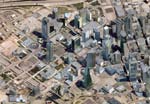
|

|
|
Home Site Search Contact Us Subscribe
|
|
|
INSIGHT: The Place of Architecture as an Art Form in the Changing Cultural Landscape The fine arts today do not have the shared social purpose they once did. But the built environment is different. Architecture is a collective art form and a collective endeavor. By Peter Gisolfi, AIA, ASLA, LEED AP December 4, 2013 Lower 5th Avenue in Manhattan is architecturally coherent. From 23rd Street south to Washington Square, the masonry buildings hold the street line and are relatively similar to each other. They are self-effacing fabric buildings that work collectively to create the outdoor space of 5th Avenue, focused on the triumphal arch in the square. Why is this so? The simple answer is that in the early 20th century, those involved in creating the cityscape agreed on informal rules of engagement. Today, things have changed.
If we look back in history, it is easy to understand that within the Western tradition, the fine arts had a primarily didactic, shared purpose. Painting told stories – the crucifixion, the annunciation, God creating Adam, etc. Sculpture was similar – portraits of important politicians, equestrian statues of generals, representations of gods and goddesses. Classical music was widely accepted, and was often used for practical purposes, such as a festival or the arrival of a monarch. Opera, which was so dominant in the 18th and 19th centuries, told understandable stories through music and drama. Similarly, the purposes of architecture were shared and practical. In ancient Roman times, a formulaic approach to constructing the city and its streets and fora was pervasive. The conventional city plan provided for movement, water distribution, and sewage. The rules of engagement for building were clearly established.
An era of individual expression
During the 20th century, due largely to technological innovation, a dramatic shift in the artistic culture of the Western tradition occurred. Radio, television, and recordings substantially replaced classical music composition and performance; as a result, there is less need today for composers and musicians. Painting and sculpture were undermined by photography and film. If we can reproduce images of nature and human beings with the click of a camera, why work for years to learn the craft that will enable us to make a Pietà? Because of these changes, music and the visual arts have become abstract and personal, the individual expressions of a much smaller community of artists. No longer are the arts obliged to appeal or connect to the lives and beliefs of the wider audience. In fact, the real living art form today is cinema. Movies, unlike the other fine arts of today, are tested constantly by the marketplace. Movies have usurped the place formerly held by music and opera.
The results of these shifts are extraordinary and unacknowledged. In our culture, the traditional artistic disciplines – music, sculpture, and painting – have become smaller and less significant. Artists today are devoted predominately to self-expression.
Architects, too, want to express themselves
How does this relate to architecture? Architects seem to want to be more like today’s painters and sculptors. They want to express themselves in individual ways. Strangely, the individual expressions of one architect tend to look similar to those of another. Cutting-edge architecture seeks to use the same rhetoric as contemporary painting and sculpture.
So, we are now confronted with a world in which architects seek original self-expression. Frequently, this includes ignoring the neighboring buildings and physical context, and favoring object buildings over more self-effacing edge buildings, such as those on Lower 5th Avenue. And what about local climate and building traditions? Do these still count? It seems they do not. In the past, with accepted rules of engagement, even mediocre architects could produce acceptable buildings. Today, we often produce trendy, self-indulgent object buildings that fall out of fashion only a few years later.
The fine arts today do not have a shared social purpose. They can be abstract and personal without dramatically harming the culture or the environment. But the built environment is different. A building has to work. It has to function. It has to solve problems. It has to be located in a specific setting. It needs an organizing idea. And it must have a way of being constructed. Craft is essential.
Architecture is a collective art form
As architects and designers of the built environment, we must accept the idea of established rules. No, I am not arguing that we should just line up buildings along a street wall. But without commonly accepted rules, uninspired attempts at individual expression will continue to proliferate.
Architecture is a collective art form and a collective endeavor. Many people work on the design, and dozens of manufacturers, tradesmen, and artisans are necessary to construct it. We have in place many rules of engagement, including prosaic directives like zoning ordinances and building codes. Where is the intellectual discipline that compels us to apply critical judgment – to evaluate the place, the setting, and the cultural environment? Where is the self-restraint that compels us to pay attention to our neighbors and to be a part of something larger than the individual building design?
Why is modern painting of no particular consequence? Why is there so little new classical music? Why doesn’t modern sculpture include craft? The major art forms are disappearing. Architecture cannot disappear; we still need buildings. Why do architects want to emulate self-expressing artists, whose art forms are in decline?
The cultural imperative for classical music, painting, and sculpture has essentially disappeared, undermined by technological innovation. Around 1900, at least 25 renowned classical composers were working. Where are today’s composers? The great pianist-composers like Brahms, Chopin, Liszt, and even Rachmaninoff were playing their own music. Today’s pianists are highly skilled interpreters, playing music by Brahms, Chopin, Liszt, and Rachmaninoff. Who is studying the craft of composition? Of painting? Of sculpture? If architecture continues to follow this path of self-expression and self-reference, it, too, may reach a dead end.
Architecture is an absolutely essential art form, and we have to look to the culture and the setting and the climate for clues about how to proceed. This is not an issue of style; it is an issue of intent. Architecture differs from the other art forms because it has a social purpose. It is functional, and it is placed in an understandable physical, climatic, and cultural setting. As architects, we must recommit ourselves to clear rules of engagement. It is a mistake to slavishly emulate the dying art forms. We have too much work to do.
Peter Gisolfi, AIA, ASLA, LEED AP, is a licensed architect and landscape architect, and a professor of architecture and landscape architecture at the Spitzer School of Architecture at the City College of New York. He is also founding partner of Peter Gisolfi Associates, Architects, Landscape Architects, in Hastings-on-Hudson, New York, and New Haven, Connecticut. His articles appear regularly in national journals. His book, Finding the Place of Architecture in the Landscape, expresses his ideas about architecture, landscape architecture, and their relationship to setting. Contact him at pgisolfi@petergisolfiassociates.com.
Also by Gisolfi:
INSIGHT: Let's Quiet
Down: The Case for Places, Regionalism, and Sustainability
INSIGHT: Small-Scale
Solution to Alternative Energy Resistance
INSIGHT:
Collaboration and Compromise: A Misunderstood Aspect of the Design Process
INSIGHT: Save What's
Left: Architects as Stewards of Our Planet
|
(click on pictures to enlarge)  Robert Mintzes New York City’s 5th Avenue, looking south to the Washington Square Arch, is architecturally coherent.  Panoramio The Arts District of Downtown Dallas, on the other hand, is disorganized. |
© 2013 ArchNewsNow.com